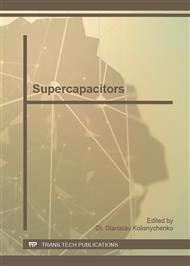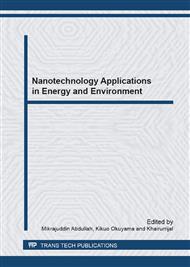p.153
p.159
p.166
p.176
p.183
p.191
p.197
p.204
p.209
Syntheses and Characterizations of Supercapacitors Using Nano-Sized ZnO/Nanoporous Carbon Electrodes and PVA-Based Polymer-Hydrogel Electrolytes
Abstract:
Supercapacitors have been successfully fabricated using nano-sized ZnO/nanoporous carbon (nano-sized ZnO/NPC) electrodes and various hydrogel electrolytes. The nano-sized ZnO/NPC materials have been prepared from zinc acetate (Zn(CH3COO)2) and coconut shell using a simple heating method. Polyvinyl alcohol (PVA) hydrogel blended with phosphoric acid (H3PO4), lithium hydroxide (LiOH) and sodium sulfate (Na2SO4) electrolytes, respectively, has been located between the electrodes. Two of the nano-sized ZnO/NPC electrodes with area of 1 cm2 and those PVA hydrogel electrolytes were pressed together and annealed at 60 °C for 60 min. to construct the supercapacitors. It has been found that the supercapacitor with nano-sized ZnO/NPC electrodes and Na2SO4 electrolyte has the highest capacitance of 60.4 Fg-1.
Info:
Periodical:
Pages:
191-196
Citation:
Online since:
January 2013
Price:
Сopyright:
© 2013 Trans Tech Publications Ltd. All Rights Reserved
Share:
Citation:



